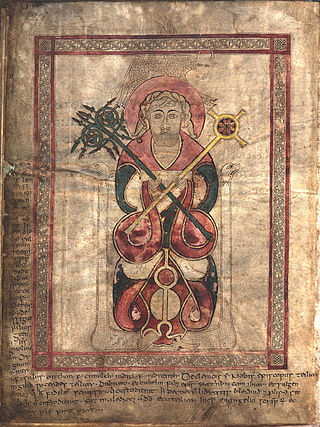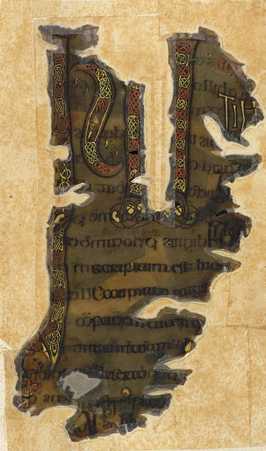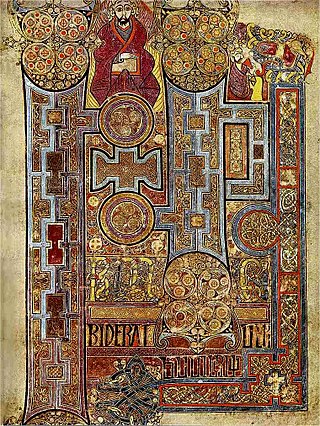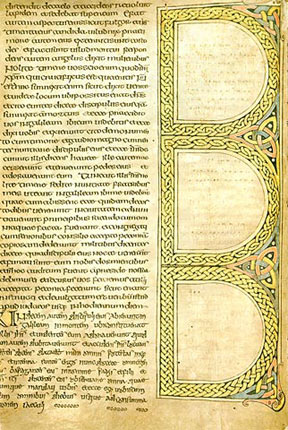
Cuthbert of Lindisfarne was a saint of the early Northumbrian church in the Celtic tradition. He was a monk, bishop and hermit, associated with the monasteries of Melrose and Lindisfarne in the Kingdom of Northumbria, today in northern England and southern Scotland. Both during his life and after his death, he became a popular medieval saint of Northern England, with a cult centred on his tomb at Durham Cathedral. Cuthbert is regarded as the patron saint of Northumbria. His feast days are 20 March and 4 September.

The Lindisfarne Gospels is an illuminated manuscript gospel book probably produced around the years 715–720 in the monastery at Lindisfarne, off the coast of Northumberland, which is now in the British Library in London. The manuscript is one of the finest works in the unique style of Hiberno-Saxon or Insular art, combining Mediterranean, Anglo-Saxon and Celtic elements.

The Book of Kells is an illuminated manuscript and Celtic Gospel book in Latin, containing the four Gospels of the New Testament together with various prefatory texts and tables. It was created in a Columban monastery in either Ireland or Scotland, and may have had contributions from various Columban institutions from each of these areas. It is believed to have been created c. 800 AD. The text of the Gospels is largely drawn from the Vulgate, although it also includes several passages drawn from the earlier versions of the Bible known as the Vetus Latina. It is regarded as a masterwork of Western calligraphy and the pinnacle of Insular illumination. The manuscript takes its name from the Abbey of Kells, County Meath, which was its home for centuries.

The St Cuthbert Gospel, also known as the Stonyhurst Gospel or the St Cuthbert Gospel of St John, is an early 8th-century pocket gospel book, written in Latin. Its finely decorated leather binding is the earliest known Western bookbinding to survive, and both the 94 vellum folios and the binding are in outstanding condition for a book of this age. With a page size of only 138 by 92 millimetres, the St Cuthbert Gospel is one of the smallest surviving Anglo-Saxon manuscripts. The essentially undecorated text is the Gospel of John in Latin, written in a script that has been regarded as a model of elegant simplicity.

The Book of Durrow is an illuminated manuscript gospel book dated to c. 700 that contains the Vulgate Latin text of the four Gospels, with some Irish variations, and other matter, written in Insular script, and richly illustrated in the style of Insular art with four full-page Evangelist symbols, six carpet pages, and many decorated initials.

The Hereford Gospels is an 8th-century illuminated manuscript gospel book in insular script (minuscule), with large illuminated initials in the Insular style. This is a very late Anglo-Saxon gospel book, which shares a distinctive style with the Caligula Troper. An added text suggests this was in the diocese of Hereford in the 11th century.

The Lichfield Gospels is an 8th-century Insular Gospel Book housed in Lichfield Cathedral. There are 236 surviving pages, eight of which are illuminated. Another four contain framed text. The pages measure 30.8 cm by 23.5 cm. The manuscript is also important because it includes, as marginalia, some of the earliest known examples of written Old Welsh, dating to the early part of the 8th century. The art historian Peter Lord dates the book at 730, placing it chronologically before the Book of Kells but after the Lindisfarne Gospels.

Durham Cathedral Library, Manuscript A.II.10. is a fragmentary seventh-century Insular Gospel Book, produced in Lindisfarne c. 650. Only seven leaves of the book survive, bound in three separate volumes in the Durham Cathedral Dean and Chapter Library. Although this book is fragmentary, it is the earliest surviving example in the series of lavish Insular Gospel Books which includes the Book of Durrow, the Lindisfarne Gospels, the Lichfield Gospels and the Book of Kells.

The Echternach Gospels were produced, presumably, at Lindisfarne Abbey in Northumbria around the year 690. This location was very significant for the production of Insular manuscripts, such as the Durham Gospels and the Lindisfarne Gospels. The scribe of the Durham Gospels is believed to have created the Echternach Gospels as well. The Echternach Gospels are now in the collection of France's Bibliothèque Nationale in Paris.

Insular script is a medieval script system originating in Ireland that spread to England and continental Europe under the influence of Irish Christianity. Irish missionaries took the script to continental Europe, where they founded monasteries, such as Bobbio. The scripts were also used in monasteries, like Fulda, which were influenced by English missionaries. They are associated with Insular art, of which most surviving examples are illuminated manuscripts. It greatly influenced modern Gaelic type and handwriting.

The St Augustine Gospels is an illuminated Gospel Book which dates from the 6th century and has been in the Parker Library in Corpus Christi College, Cambridge since 1575. It was made in Italy and has been in England since fairly soon after its creation; by the 16th century it had probably already been at Canterbury for almost a thousand years. It has 265 leaves measuring about 252 x 196 mm, and is not entirely complete, in particular missing pages with miniatures.

British Library, Add MS 40618 is a late 8th century illuminated Irish Gospel Book with 10th century Anglo-Saxon additions. The manuscript contains a portion of the Gospel of Matthew, the majority of the Gospel of Mark and the entirety of the Gospels of Luke and John. There are three surviving Evangelist portraits, one original and two 10th century replacements, along with 10th century decorated initials. It is catalogued as number 40618 in the Additional manuscripts collection at the British Library.

The Otho-Corpus Gospels is a badly damaged and fragmentary 8th century illuminated manuscript. It was part of the Cotton library and was mostly burnt in the 1731 fire at Ashburnham House. The manuscript now survives as charred fragments in the British Library. Thirty six pages of the manuscript were not in the Cotton collection and survived the fire. They are now in the library of Corpus Christi College, Cambridge.

Insular art, also known as Hiberno-Saxon art, was produced in the post-Roman era of Great Britain and Ireland. The term derives from insula, the Latin term for "island"; in this period Britain and Ireland shared a largely common style different from that of the rest of Europe. Art historians usually group Insular art as part of the Migration Period art movement as well as Early Medieval Western art, and it is the combination of these two traditions that gives the style its special character.
Durham Gospel Fragment may refer to any of three manuscripts now housed in the library at Durham Cathedral.

In the visual arts, interlace is a decorative element found in medieval art. In interlace, bands or portions of other motifs are looped, braided, and knotted in complex geometric patterns, often to fill a space. Interlacing is common in the Migration period art of Northern Europe, in the early medieval Insular art of Britain and Ireland, and Norse art of the Early Middle Ages, and in Islamic art.
Billfrith is an obscure Northumbrian saint credited with providing the jewel and metalwork encrusting the former treasure binding of the Lindisfarne Gospels. His name is thought to mean "peace of the two-edge sword".
Aldred the Scribe is the name by which scholars identify a tenth-century priest, otherwise known only as Aldred, who was a provost of the monastic community of St. Cuthbert at Chester-le-Street in 970.

The Durham Dean and Chapter Library, also known as Durham Cathedral Library, is located in Durham Cathedral, Durham, England. Founded in 995 AD, it is one of the largest English cathedral libraries. William de St-Calais donated 46 books. In the 19th century it was located in the Old Frater House, or Monk's Hall, on the south side of the cathedral's cloisters, situated there in 1680 by the Dean of Durham John Sudbury, who fitted up the building.
















